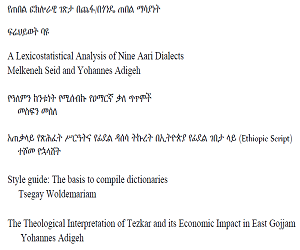A Lexicostatistical Analysis of Nine Aari Dialects
Abstract
This article deals with a lexicostatistical analysis of the nine Aari varieties: Gayl, Sido, Woba, Layda, Biyo, Shengama, Baaka, Kure and Kaysa. The right names and numbers of Aari dialects or language varieties have been describing in different ways in many past literatures and again there were no thorough studies on the mutual intelligibility level of all the language varieties of Aari. In order to show an overall intelligibility level between language varieties, lexical, phonological and grammatical (morphological and syntactical) comparisons are needed. Therefore, to fill the gap, in this article a lexical comparisons among the nine Aari language varieties are discussed. The lexical comparisons were done in three different categories (completely similar, partially similar and completely different vocabularies) based on 324 lexical items from each language variety. As a result, depending on percentages of completely similar shared lexicons the varieties are ranked from the highest to the least as Layda, Shengama, Biyo, Kure, Woba, Baaka, Sido, Kaysa and Gayl. In the second partially similar category the varieties are ranked from the highest shared percentage to the least as follows: Gayl, Sido, Woba, Baaka, Biyo, Kure, Kaysa, Shengama and Layda. In the third and final category of unshared vocabularies percentages, the language varieties are ranked from the highest unshared or dissimilar variety to the least unshared one based on their dissimilarity level as follows: Gayl, Kaysa, Sido & Baaka, Woba, Kure, Biyo, Shengama and Layda. Finally, in the total RPV (a rank position value) result of completely similar vocabularies, based on their similarities language varieties are clustered in four groups from highest to the least one. Here, the clustering shows that lexically Layda language variety is considered as the center for the rest of all varieties. In contrast, the varieties Kaysa and Gayl have the least shared lexicons than the rest seven varieties or lexically they are too different than all the rest Aari varieties.
Downloads
References
Bender, ML. 1989. “Comparative Aroid (South Omotic) Morphology” Paper prepared for 2nd International Symposium on Cushitic and Omotic Nov. 16-18, Turin, Italy.
Burton, Philip (2007). Working with Dialect Translations. Retrieved on 31 June 2017 from http://www.hca.heacademy.ac.uk/resources/classics/coll04/Burton.pdf.
Chambers, J. K., and Peter Trudgill (1998). Dialectology (2nd ed.). Cambridge: Cambridge University Press.
Cheng, Chin-Chuan (1992). Syllable-Based Dialect Classification and Mutual Intelligibility
Crystal, D. 2000. Language Death. Cambridge: Cambridge University Press.
Fekede Menuta. 2011. Aari Language: A Comparative Grammar. Addis Ababa: Bole Printing Enterprise.
Ford Carolyn.1985. Report on Aari Linguistic Survey. Submitted to Language Academy. Ministry of Culture. Addis Ababa, Ethiopia (unpublished)
Francis, W. N. (1983). Dialectology. New York: Longman Inc.
Groves M. Julie “Language or Dialect—or Topolect?” Sino-Platonic Papers, 179 (February, 2008).
More inside the PDF
